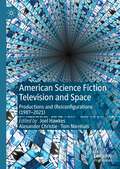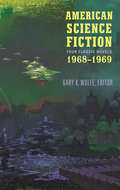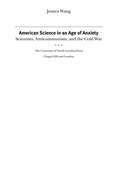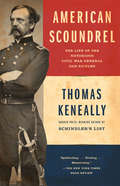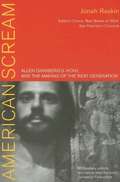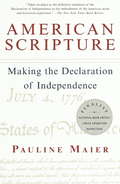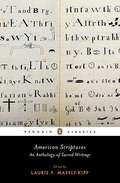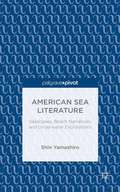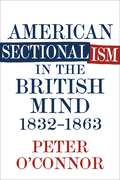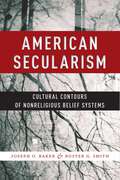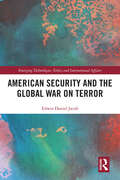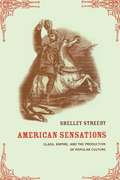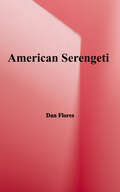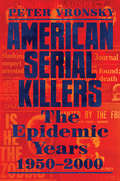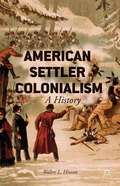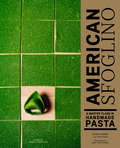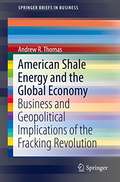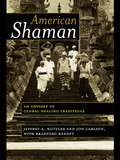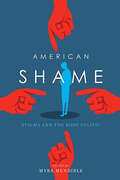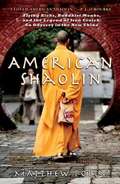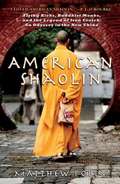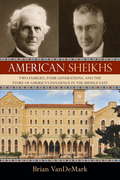- Table View
- List View
American Schools: The $100 Billion Challenge
by Dwight Allen Jr. William H. Cosby Jr.Exchanging comedy for community activism, Bill Cosby teams up with Dwight Allen, Eminent Professor of Education Reform at Old Dominion University, to issue a challenge to the federal government and the new captains of industry: produce one hundred billion dollars and reform, revamp, and reinvent our schools. Together, Cosby and Allen do more than discuss the problems- the crumbling buildings, flagging test scores, and failing students- they offer concrete solutions, outlining a point-by-point plan for putting dot-com dollars to work.
American Science Fiction Television and Space: Productions and (Re)configurations (1987-2021)
by Joel Hawkes Alex Christie Tom NienhuisThis collection reads the science fiction genre and television medium as examples of heterotopia (and television as science fiction technology), in which forms, processes, and productions of space and time collide – a multiplicity of spaces produced and (re)configured. The book looks to be a heterotopic production, with different chapters and “spaces” (of genre, production, mediums, technologies, homes, bodies, etc), reflecting, refracting, and colliding to offer insight into spatial relationships and the implications of these spaces for a society that increasingly inhabits the world through the space of the screen. A focus on American science fiction offers further spatial focus for this study – a question of geographical and cultural borders and influence not only in terms of American science fiction but American television and streaming services. The (contested) hegemonic nature of American science fiction television will be discussed alongside a nation that has significantly been understood, even produced, through the television screen. Essays will examine the various (re)configurations, or productions, of space as they collapse into the science fiction heterotopia of television since 1987, the year Star Trek: Next Generation began airing.
American Science Fiction and the Cold War: Literature and Film (America In The 20th/21st Century Ser. #Vol. 3)
by David SeedFirst Published in 1999. Routledge is an imprint of Taylor & Francis, an informa company.
American Science Fiction: Four Classic Novels 1960-1966 (LOA #321)
by Poul Anderson Clifford D. Simak Daniel Keyes Roger ZelasnyIn a deluxe collector's edition hardcover, four classic novels from science fiction's most transformative decade, including the landmark Flowers for AlgernonThis volume, the first of a two-volume set gathering the best American science fiction from the tumultuous 1960s, opens with Poul Anderson's immensely popular The High Crusade, in which aliens planning to conquer Earth land in Lincolnshire during the Hundred Years' War. In Clifford Simak's Hugo Award-winning Way Station, Enoch Wallace is a spry 124-year-old Civil War veteran whose lifelong job monitoring the intergalactic pit stop inside his home is largely uneventful--until a CIA agent shows up and Cold War hostilities threaten the peaceful harmony of the Galactic confederation. Daniel Keyes's beloved Flowers for Algernon, winner of the Nebula Award and adapted as the Academy Award-winning movie Charly, is told through the journal entries of Charlie Gordon, a young man with severe learning disabilities who is the test subject for surgery to improve his intelligence. And in the postapocalyptic earthscape of Roger Zelazny's Hugo Award-winning . . . And Call Me Conrad (also published as This Immortal) Conrad Nomikos reluctantly accepts the responsibility of showing the planet to the governing extraterrestrials' representative and protecting him from rebellious remnants of the human race. Using early manuscripts and original setting copy, this Library of America volume restores the novel to a version that most closely approximates Zelazny's original text.
American Science Fiction: Four Classic Novels 1968-1969 (LOA #322)
by Joanna Russ Jack Vance Samuel R. Delany R. A. LaffertyFour mind-bending novels from science fiction's most transformative decade in a deluxe collector's edition hardcover, including two long out-of-print classicsIn this second volume of a two-volume set gathering the best American science fiction from the tumultuous 1960s, R. A. Lafferty's quirky and utterly original Past Master, an unjustly neglected classic, imagines Sir Thomas More transported to the colony Astrobe in the year 2535, where he is made president of a future Utopia. In Picnic on Paradise, Joanna Russ presents her indelible heroine, Alyx, who is hired to protect a group of tourists in a hostile alien world. Samuel R. Delany's proto-cyberpunk space opera Nova, reprinted here for the first time in a text corrected by the author, combines the pacing of a revenge story with the arc of a grail-quest legend. Jack Vance's dystopian thriller Emphyrio is the coming-of-age story of Ghyl, who has been raised in a world barring the use of automation but has a strong sense of subversive individualism. The novel has been restored to the author's original text, without later editorial interventions.
American Science in an Age of Anxiety
by Jessica WangNo professional group in the United States benefited more from World War II than the scientific community. After the atomic bombings of Hiroshima and Nagasaki, scientists enjoyed unprecedented public visibility and political influence as a new elite whose expertise now seemed critical to America's future. But as the United States grew committed to Cold War conflict with the Soviet Union and the ideology of anticommunism came to dominate American politics, scientists faced an increasingly vigorous regimen of security and loyalty clearances as well as the threat of intrusive investigations by the notorious House Committee on Un-American Activities and other government bodies.This book is the first major study of American scientists' encounters with Cold War anticommunism in the decade after World War II. By examining cases of individual scientists subjected to loyalty and security investigations, the organizational response of the scientific community to political attacks, and the relationships between Cold War ideology and postwar science policy, Jessica Wang demonstrates the stifling effects of anticommunist ideology on the politics of science. She exposes the deep divisions over the Cold War within the scientific community and provides a complex story of hard choices, a community in crisis, and roads not taken.
American Scoundrel: The Life of the Notorious Civil War General Dan Sickles
by Thomas KeneallyOn the last Sunday of February 1859, Dan Sickles, a charming young congressman from New York, murdered his good friend Philip Barton Key (son of Francis Scott Key)–who was also his wife’s lover–in Washington’s Lafayette Square. The shooting took place directly across the street from the White House, the home of Sickles’s friend and protector, President James Buchanan. Sickles turned himself in; political friends in New York’s Tammany Hall machinery, including the dynamic criminal lawyer James Brady, quickly gathered around. While his beautiful young wife was banned from public life and shunned by society, Dan Sickles was acquitted. American Scoundrel is the extraordinary story of this powerful mid-nineteenth century politician and inveterate womanizer, whose irresistible charms and rock-solid connections not only allowed him to get away with murder — literally — but also paved the way to a stunning career. Once free to resume his life, Dan Sickles raised a regiment for the Union political elite and went on to become a general in the army, rising to the rank of brigadier general and commanding a flank at the Battle of Gettysburg in a maneuver so controversial it is still argued over by scholars today. After losing a leg in that battle, Sickles fought on and after the war became military governor of South Carolina, and later was named minister to Spain, where he continued astonishingly to conduct his amorous assignations. With great brio and insight — and a delight in bad behavior — Thomas Keneally has brought to light a tale of American history that resonates with uncomfortable truths about our politics, ethics, and morality.
American Scream: Allen Ginsberg's Howl and the Making of the Beat Generation
by Jonah RaskinBiography of Allen Ginsberg, best known for his poem Howl, the emblem of the Beat Generation.
American Scripture: Making the Declaration of Independence
by Pauline MaierPauline Maier shows us the Declaration as both the defining statement of our national identity and the moral standard by which we live as a nation. It is truly "American Scripture," and Maier tells us how it came to be -- from the Declaration's birth in the hard and tortuous struggle by which Americans arrived at Independence to the ways in which, in the nineteenth century, the document itself became sanctified.Maier describes the transformation of the Second Continental Congress into a national government, unlike anything that preceded or followed it, and with more authority than the colonists would ever have conceded to the British Parliament; the great difficulty in making the decision for Independence; the influence of Paine's []Common Sense[], which shifted the terms of debate; and the political maneuvers that allowed Congress to make the momentous decision.In Maier's hands, the Declaration of Independence is brought close to us. She lets us hear the voice of the people as revealed in the other "declarations" of 1776: the local resolutions -- most of which have gone unnoticed over the past two centuries -- that explained, advocated, and justified Independence and undergirded Congress's work. Detective-like, she discloses the origins of key ideas and phrases in the Declaration and unravels the complex story of its drafting and of the group-editing job which angered Thomas Jefferson.Maier also reveals what happened to the Declaration after the signing and celebration: how it was largely forgotten and then revived to buttress political arguments of the nineteenth century; and, most important, how Abraham Lincoln ensured its persistence as a living force in American society. Finally, she shows how by the very act of venerating the Declaration as we do -- by holding it as sacrosanct, akin to holy writ -- we may actually be betraying its purpose and its power.From the Hardcover edition.
American Scriptures
by Laurie F. Maffly-KippA groundbreaking collection of sacred Christian writings of American origin from Mormons, Shakers, Christian Scientists, and others. "Scripture" is any work in which the authors, translators, editors, or discoverers all claim to have received wisdom from a source outside themselves, be it revelation, enlightened philosophy, or ancient archive. For the first time in a single volume, American Scriptures gathers fifteen of these texts from religious movements with origins in the United States. Laurie F. Maffly-Kipp's concise single volume will enlighten not only readers interested in the historical and religious aspects of the scriptural texts, but also those whose interest has been piqued by such bestsellers as Angels and Demons and The Da Vinci Code.
American Sea Literature: Seascapes, Beach Narratives, and Underwater Explorations
by Shin YamashiroImplementing a never-before-seen approach to sea literature, American Sea Literature: Seascapes, Beach Narratives, and Underwater Explorations explores the role of American maritime activities and their cultural representations in literature. Differentiating between the 'terrestrial' and 'oceanic' as concepts, Shin Yamashiro divides sea literature into three categories: literature on the sea, by the sea, and beneath the sea. Discussing both canonical works and new books on scuba diving, deep-sea explorations, and surfing, this fascinating study recognizes sea literature's unique influence on American history.
American Sectionalism in the British Mind, 1832-1863
by Peter O'ConnorIn American Sectionalism in the British Mind, 1832–1863, Peter O’Connor uses an innovative interdisciplinary approach to provide a corrective to simplified interpretations of British attitudes towards the United States during the antebellum and early Civil War periods. Exploring the many complexities of transatlantic politics and culture, O’Connor examines developing British ideas about U.S. sectionalism, from the abolition of slavery in the British Empire and the Nullification Crisis in South Carolina to the Civil War.Through a close reading of travelogues, fictional accounts, newspaper reports, and personal papers, O’Connor argues that the British literate population had a longstanding familiarity with U.S. sectionalism and with the complex identities of the North and South. As a consequence of their engagement with published accounts of America produced in the decades leading up to the Civil War, the British populace approached the conflict through these preexisting notions.O’Connor reveals even antislavery commentators tended to criticize slavery in the abstract and to highlight elements of the system that they believed compared favorably to the condition of free blacks in the North. As a result, the British saw slavery in the U.S. in national as opposed to sectional terms, which collapsed the moral division between North and South. O’Connor argues that the British identified three regions within America—the British Cavalier South, the British Puritan New England, and the ethnically heterogeneous New York and Pennsylvania region—and demonstrates how the apparent lack of a national American culture prepared Britons for the idea of disunity within the U.S. He then goes on to highlight how British commentators engaged with American debates over political culture, political policy, and states’ rights. In doing so, he reveals the complexity of the British understanding of American sectionalism in the antebellum era and its consequences for British public opinion during the Civil War.American Sectionalism in the British Mind, 1832–1863 re-conceptualizes our understanding of British engagements with the United States during the mid-nineteenth century, offering a new explanation of how the British understood America in the antebellum and Civil War eras.
American Secularism: Cultural Contours of Nonreligious Belief Systems (Religion and Social Transformation #3)
by Joseph O. Baker Buster G. SmithHonorable Mention, American Sociological Association Section on Religion Distinguished Book AwardA rapidly growing number of Americans are embracing life outside the bounds of organized religion. Although America has long been viewed as a fervently religious Christian nation, survey data shows that more and more Americans are identifying as “not religious.” There are more non-religious Americans than ever before, yet social scientists have not adequately studied or typologized secularities, and the lived reality of secular individuals in America has not been astutely analyzed. American Secularism documents how changes to American society have fueled these shifts in the non-religious landscape and examines the diverse and dynamic world of secular Americans.This volume offers a theoretical framework for understanding secularisms. It explores secular Americans’ thought and practice to understand secularisms as worldviews in their own right, not just as negations of religion. Drawing on empirical data, the authors examine how people live secular lives and make meaning outside of organized religion. Joseph O. Baker and Buster G. Smith link secularities to broader issues of social power and organization, providing an empirical and cultural perspective on the secular landscape. In so doing, they demonstrate that shifts in American secularism are reflective of changes in the political meanings of “religion” in American culture.American Secularism addresses the contemporary lived reality of secular individuals, outlining forms of secular identity and showing their connection to patterns of family formation, sexuality, and politics, providing scholars of religion with a more comprehensive understanding of worldviews that do not include traditional religion. Data Analyses Appendix
American Security and the Global War on Terror
by Edwin Daniel JacobThis book delivers an interpretive framework for making sense of today’s geopolitical landscape and casts new light on the impact ideology and technology have had on American foreign policy and contemporary security practices. Edwin Daniel Jacob argues that America’s security practices in the Global War on Terror have been guided by an anachronistic Cold War logic that has subordinated strategy to tactics. Jacob shows that deep-rooted prejudices and presuppositions regarding American exceptionalism have had a disastrous impact on the policies of the United States, not only in dealing with terrorism, but also in seeking to impose American hegemony in the Middle East. Ineffectual security practices of dubious moral character, from rendition and torture to preemptive strikes and nation building to drones and assassinations, privilege exigency over ethics. Yet the result of this "post-strategic" approach to security, where interchangeable tactics, like these, masquerade as strategy, only increases insecurity. Jacob offers a fresh perspective on American foreign policy that links national security with human security in regional terms. This approach highlights the need for order, predictability, and stability—the cornerstone of political realism. Making use of insights derived from Machiavelli, Hobbes, Marx, Weber, Schmitt, and Morgenthau, this interdisciplinary work provides an overview of American foreign policy in the twenty-first century and speaks to crucial themes in the fields of history, political science, and sociology.
American Sensations: Class, Empire, and the Production of Popular Culture
by Shelley StreebyBy focusing on sensationalist literature of the period, Streeby explores issues of race, class, popular culture, and notions of empire in America around the U.S.-Mexican war.
American Serengeti: The Last Big Animals of the Great Plains
by Dan FloresAmerica's Great Plains once possessed one of the grandest wildlife spectacles of the world, equaled only by such places as the Serengeti, the Masai Mara, or the veld of South Africa. Pronghorn antelope, gray wolves, bison, coyotes, wild horses, and grizzly bears: less than two hundred years ago these creatures existed in such abundance that John James Audubon was moved to write, "it is impossible to describe or even conceive the vast multitudes of these animals." In a work that is at once a lyrical evocation of that lost splendor and a detailed natural history of these charismatic species of the historic Great Plains, veteran naturalist and outdoorsman Dan Flores draws a vivid portrait of each of these animals in their glory--and tells the harrowing story of what happened to them at the hands of market hunters and ranchers and ultimately a federal killing program in the nineteenth and twentieth centuries. The Great Plains with its wildlife intact dazzled Americans and Europeans alike, prompting numerous literary tributes. American Serengeti takes its place alongside these celebratory works, showing us the grazers and predators of the plains against the vast opalescent distances, the blue mountains shimmering on the horizon, the great rippling tracts of yellowed grasslands. Far from the empty "flyover country" of recent times, this landscape is alive with a complex ecology at least 20,000 years old--a continental patrimony whose wonders may not be entirely lost, as recent efforts hold out hope of partial restoration of these historic species. Written by an author who has done breakthrough work on the histories of several of these animals--including bison, wild horses, and coyotes--American Serengeti is as rigorous in its research as it is intimate in its sense of wonder--the most deeply informed, closely observed view we have of the Great Plains' wild heritage.
American Serial Killers: The Epidemic Years 1950-2000
by Peter VronskyFans of Mindhunter and true crime podcasts will devour these chilling stories of serial killers from the American "Golden Age" (1950-2000). With books like Serial Killers, Female Serial Killers and Sons of Cain, Peter Vronsky has established himself as the foremost expert on the history of serial killers. In this first definitive history of the "Golden Age" of American serial murder, when the number and body count of serial killers exploded, Vronsky tells the stories of the most unusual and prominent serial killings from the 1950s to the early twenty-first century. From Ted Bundy to the Golden State Killer, our fascination with these classic serial killers seems to grow by the day. American Serial Killers gives true crime junkies what they crave, with both perennial favorites (Ed Kemper, Jeffrey Dahmer) and lesser-known cases (Melvin Rees, Harvey Glatman).
American Settler Colonialism
by Walter L. Hixson 2013Over the course of three centuries, American settlers helped to create the richest, most powerful nation in human history, even as they killed and displaced millions. This groundbreaking work shows that American history is defined by settler colonialism, providing a compelling framework through which to understand its rise to global dominance.
American Sfoglino: A Master Class in Handmade Pasta
by Evan Funke Katie Parla*THE JAMES BEARD MEDIA AWARD WINNER FOR BEST PHOTOGRAPHY*"Evan Funke's respect for tradition and detail makes American Sfoglino the perfect introduction to the fresh egg pastas of Emilia Romagna. It's bold in its simplicity and focus." — Missy Robbins, chef/owner of Lilia and MISIForget your pasta machine and indulge in the magic of being a sfoglino with the help of the rich imagery and detailed instructions provided by Evan Funke and American Sfoglino.A comprehensive guide to making the best pasta in the world: In this debut cookbook from Evan Funke, he shares classic techniques from his Emilia Romagna training and provides accessible instructions for making his award winning sfoglia (sheet pasta) at home. With little more than flour, eggs, and a rolling pin, you too can be a sfoglino (a pasta maker) and create traditional Italian noodles that are perfectly paired with the right sauces.Features recipes for home cooks to recreate 15 classic pasta shapes, spanning simple pappardelle to perfect tortelloni.Beginning with four foundational doughs, American Sfoglino takes readers step by step through recipes for a variety of generous dishes, from essential sauces and broths, like Passata di Pomodoro (Tomato Sauce) and Brodo di Carne (Meat Broth) to luscious Tagliatelle in Bianco con Prosciutto (Tagliatelle with Bacon and Butter) and Lasagna Verde alla Bolognese (Green Bolognese Lasagna) in this treasure trove of a recipe book.Includes stories from Italy and the kitchen at Funke's Felix Trattoria that add the finishing touches to this pasta masterclass, while sumptuous James Beard-award winning photographs and a bold package offer a feast for the eyes.Evan Funke is a master pasta maker and the chef owner of Felix Trattoria in Venice, California. Katie Parla is a food writer and IACP award winning author whose work has appeared in numerous outlets, including the New York Times, Food & Wine, and Saveur. Eric Wolfinger is a James Beard Award winning food photographer.Makes an excellent gift idea for any pasta aficionado or avid Italian cook.
American Shale Energy and the Global Economy: Business And Geopolitical Implications Of The Fracking Revolution (SpringerBriefs In Business)
by Andrew R. ThomasProvides a rational, comprehensive overview of the major business themes and management implications of the new abundance of natural gas in the U.S.<P><P> Explores the hopes and hazards posed by natural gas extraction techniques (i.e., fracking).<P> Examine the ways shale energy impacts supply chains for firms.<P> Identifies significant geopolitical consideration surrounding the rise of shale energy.<P> This brief explores the business and global implications of the American shale energy, or natural gas, revolution. Specifically, it provides a rational, comprehensive look at the major business themes and management implications that surround the new abundance of natural gas in the United States and identifies some of the most significant geopolitical considerations globally. While acknowledging some of the controversies and hazards surrounding the extraction techniques, commonly known as “fracking”, the author also looks at the hopes this technique poses and details how shale energy will impact supply chains for firms. <P> The discovery of new sources of domestic natural gas in recent years - coupled with innovations that facilitated their extraction - has altered the global landscape. However, the vast majority of the information out there for business students, faculty, and practitioners about the natural gas revolution is focused on the impact of “longer and lower” energy prices; and, secondarily, opportunities within the domestic energy sector. Each of these is crucial for business people to understand, however, the natural gas revolution is about much more. Companies of all sizes, whether they see it or not, are having new opportunities open up for their products and services. Further, the globalization of shale energy will have far reaching influence beyond simply economic factors. Geopolitical considerations and the re-structuring of international relations around shale energy will impact supply chains in a myriad of ways. This book aims to examine these opportunities.<P> Featuring case studies from contemporary companies, this book will be of interest to students, academics, researchers, professionals and policy makers who are seeking to understand the business and global implications of the shale energy revolution.
American Shaman: An Odyssey of Global Healing Traditions
by Jeffrey A. Kottler Jon Carlson Bradford KeeneyWritten for therapists, scholars, clergy, students, and those with an interest in non-traditional healing practices, this book tells the story of Bradford Keeney, the first non-African to be inducted as a shaman in the Kung Bushman and Zulu cultures.
American Shame: Stigma and the Body Politic
by Myra MendibleOn any given day in America's news cycle, stories and images of disgraced politicians and celebrities solicit our moral indignation, their misdeeds fueling a lucrative economy of shame and scandal. Shame is one of the most coercive, painful, and intriguing of human emotions. Only in recent years has interest in shame extended beyond a focus on the subjective experience of this emotion and its psychological effects. The essays collected here consider the role of shame as cultural practice and examine ways that public shaming practices enforce conformity and group coherence. Addressing abortion, mental illness, suicide, immigration, and body image among other issues, this volume calls attention to the ways shaming practices create and police social boundaries; how shaming speech is endorsed, judged, or challenged by various groups; and the distinct ways that shame is encoded and embodied in a nation that prides itself on individualism, diversity, and exceptionalism. Examining shame through a prism of race, sexuality, ethnicity, and gender, these provocative essays offer a broader understanding of how America's discourse of shame helps to define its people as citizens, spectators, consumers, and moral actors.
American Shaolin: An Odyssey in the New China
by Matthew PollyAutobiographical account of the author, who was the target of the bullies at school. He wanted to become a strong fighter and so attended the Shaolin temple in China where the martial arts are taught.
American Shaolin: Flying Kicks, Buddhist Monks, and the Legend of Iron Crotch: An Odyssey in theNe w China
by Matthew PollyMatthew Polly was your typical 98-pound weakling with sand kicked in his face - until he decided to learn to kick back. Dropping out of university, he travelled to China to study at the granddaddy of all Chinese martial arts monasteries: the Shaolin Temple, the birthplace of both Zen Buddhism and kungfu. But, as Confucius might have said, path to becoming kung fu master very difficult. For one thing, no one knew where exactly the Shaolin Temple was. And asking for directions proved problematic - after three years spent learning Mandarin in college, Matthew couldn't understand a word outside the classroom. He finally found the Shaolin village hidden away between five mountain peaks. But the hard part was yet to come. The Chinese term for tough training is chi ku (eating bitter) - and Matthew quickly leaned to appreciate the phrase. By the end of the second day of training his knees were in agony and he was walking like the dead - and that was just the induction. American Shaolin is the hilarious story of Matthew's remarkable two-year travel odyssey - a tale of gruelling training, forbidden romance and an eye-watering insight into the art of 'iron-crotch' kungfu.
American Sheikhs
by Brian VandemarkIn addition to their ability to overcome cultural barriers and think independently, the greatest minds in Middle Eastern politics and culture share a common background: they graduated from the American University of Beirut. AUB graduates, whose lives and accomplishments played a significant role in much of the modern history in this critical region of the world, include countless leaders, legislators, ambassadors, educators, scientists, doctors, and businesspeople. Persons such as philosopher and diplomat Charles Malik; Lebanon's former prime minister Fouad Siniora; Arab League ambassador to France Nasif Hitti; and Rula Dashti, one of the first four women to win a seat in Kuwait's House of Parliament, are just a few of the exemplary alumni who embody the ideals of the AUB.In 1866, American missionaries founded a small college in Beirut, Lebanon, called the Syrian Protestant College. Later renamed the American University of Beirut, what began as a humble missionary school grew to become the most influential institution of higher education in the Middle East. Originally created by Reverend Daniel Bliss with the financial backing of businessman William E. Dodge, the AUB, under the leadership of four generations of the Bliss and Dodge families, became the preeminent symbol of American culture and values in the Middle East. This author's vivid narrative not only includes the colorful history of the AUB and many memorable episodes in a dual family saga but also pursues larger and more important themes. In the story of the efforts of these two families to build a great school with alternating audacity, arrogance, generosity, paternalism, and vision, the author clearly sees an allegory for the larger history of the United States in the Middle East.With the ideas of American nationalism and presumptions of Manifest Destiny, arrogant missionaries came to the Middle East in the nineteenth century looking to convert Muslims to Christianity. Through hard experience, these Americans learned to engage Middle Easterners on their own terms--by teaching them, rather than preaching to them. With that, the AUB shifted its focus from religious conversion to educational enlightenment and independent thinking. In doing so, both men and women, whether they be Muslim, Jew, or Christian, generally viewed the school as an engine of constructive change and the United States as a benign force in the region. Long before conflicts over oil, the state of Israel, and military intervention became the prevalent motifs of US involvement in the region, Americans and Middle Easterners encountered one another, learned to work together, and came to understand one another because the AUB served as neutral ground where tolerance and mutual respect prevailed.But in the post-World War II era, with the rise of America as a world power, the AUB found itself buffeted by the strong winds of nationalist frustration, Zionism and anti-Zionism, and eventually Islamic extremism. Middle Easterners became more ambivalent about America's purposes and began to perceive the university not just as a cradle of learning but also as an agent of undesirable Western interests. Despite the tumultuous atmosphere of civil war in Lebanon, foreign invasions throughout the Middle East, and daily riots and bombings in Beirut, the AUB remained intact, holding fast to the ideals of intercultural engagement and mutual regard for diverse points of view.This story is full of meaning today. By revealing how and why the Blisses and Dodges both succeeded and failed in their attempts to influence the Middle East, the author shows how America's outreach in the region can be improved, and he explains the vital importance of maintaining good relations between Americans and the Muslim world in the new century. AThis book tells the story of America giving to, rather than taking from, the nations and peoples of this vitally important yet volatile area. It is a model for how Americans and Middle Easterners of all faiths and perspectives can learn to work together.

